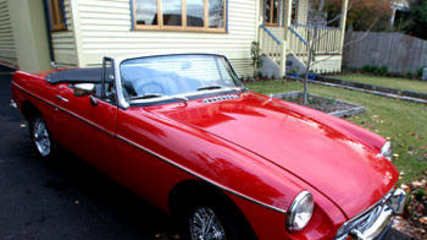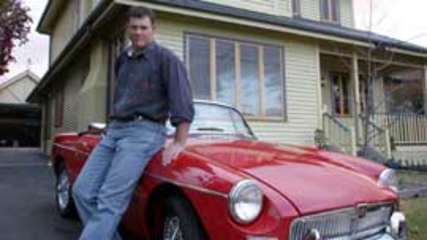1969 MG B Reviews
You'll find all our 1969 MG B reviews right here. 1969 MG B prices range from $11,550 for the B Sports Mk Ii to $15,400 for the B Sports Mk Ii.
Our reviews offer detailed analysis of the 's features, design, practicality, fuel consumption, engine and transmission, safety, ownership and what it's like to drive.
The most recent reviews sit up the top of the page, but if you're looking for an older model year or shopping for a used car, scroll down to find MG dating back as far as 1963.
Or, if you just want to read the latest news about the MG B, you'll find it all here.

Used MG B review: 1963-1972
Read the article
By Graham Smith · 29 Jan 2009
The MGB was greeted with great excitement when it arrived here in 1963. It was the latest in a long line of sports cars from the British carmaker that had come to define the very essence of what a sports car should be, but the B also caused a sensation because it was such a shift away from MG tradition.When earlier MGs were stripped down to the bare minimum, had a bone jarring ride that threatened to shake the fillings from your teeth, the B was as smooth as silk. MG traditionalists were aghast at this newcomer they regarded as soft and for sissies.MODEL WATCHThe B had indeed departed from MG tradition, but the result was a smooth and sophisticated sports car for its time.Gone was the separate chassis used on previous models, the B was MG’s first unitary construction car, and that resulted in a much stiffer car with more predictable and precise handling.It was also pretty, with classical long nose and stubby tail proportions, and clean uncluttered lines, although critics at the time had problems coming to terms with the fins that had grown from the rear guards.The mechanical package was simple. The engine was a BMC B-series four-cylinder engine of 1.8 litres capacity. It was a long stroke unit with pushrod actuated overhead valves and was fed by twin SU carburettors.On full song the B put out 71 kW of power at 5500 revs, and 145 Nm of torque at 3500 revs, enough to push the 920 kg roadster to 97 km/h in 11.3 seconds, and through the standing 400-metre sprint in 18.2 seconds. When pushed to the limit it would reach 170 km/h.The numbers rightly suggest the B was no fire-breathing monster; nevertheless it was quite spirited for its day.When first released the transmission was a four-speed manual with synchromesh on the top three gears, and a precise gearshift.Underneath, the B had independent front suspension with coil springs and lever type hydraulic shock absorbers, while at the rear it had a live axle slung from semi-elliptic leaf springs and lever type shocks.The B’s brakes were quite good for the time, with solid discs at the front and drums at the rear.Rack and pinion steering was direct, but precise and with quite good feel.Wire wheels, 14 x 4.5 inches, finished off the picture of a classic sports car and the tyres were radials. In standard form the wheels were painted silver, but for an extra dash of gloss they could be bright chrome plated.Inside, the B was quite roomy by sports car standards. It had a broad cockpit with a pair of black trimmed sports buckets either side of the centre tunnel. Carpets covered the floor; there was a black thin-rimmed wire-spoked steering wheel and a full complement of Smiths black-faced gauges.A smoother engine, with five main bearings instead of three, was launched in 1965, and an electrically operated overdrive gearbox followed in 1968.Later in 1968 BMC released the Mk II B, which then boasted an all-synchromesh gearbox as the main change.The final act came in 1970 when the B was replaced by the restyled L, which ran through to 1972 when the then British Leyland ceased local production. The B continued in production in England until the 1980s when it was finally put to rest.A number of these later cars, generally referred to as rubber bumper cars because of their American low speed crash bumpers, have been imported over the years, but don’t have the same appeal as the original chrome bumper cars built here.IN THE SHOPThe simplicity of the B makes it perfect for a restoration project, the sort that bonds a father and son, but beware of restoration costs because they often blow out of control to the point they can exceed by many times the price of buying a car already restored.Rust is the main problem with the B, as it is with any car that’s 40 years or more old. Look for rust in the sills, the floors, around the battery boxes behind the seats, in the front guards, boot floor and in the scuttle.Rust repairs really require expert skills and shouldn’t be tackled at home unless you have the experience to do them properly.It’s best to search for a car that has minimal rust, even if the mechanicals are worn out because it’s much easier to rebuild the engine, gearbox, suspension, steering and brakes at home than it is to cut out rust.The good news is that parts are readily available from specialists, and they don’t cost an arm and a leg by classic standards.The B is also a good base on which to develop and improve. There’s plenty of specialist knowledge available on what to do to improve the performance, and handling, like fitting telescopic shocks absorbers in place of the old level type.OWNERS’ VIEWSJim Bradley was attracted to the MGB when as a young man he saw one zipping around his hometown of Woodend. Later, as an 18-year-old he bought a three main bearing '64 model, which he says caused him nothing but trouble, but looked charming and he missed driving it after it was sold. Ten years later he restored his father’s B, which was in a very poor state. He enjoys the characteristic engine note, reasonable performance and handling.LOOK FOR• good looking classic sports car• solid unibody construction• modest performance by today’s standards• good brakes• avoid rusty resto rockets• ready supply of replacement parts at reasonable cost• affordable fun classic• great club sceneVERDICTSmooth driving and affordable classic British sports car that won’t send you broke if it breaks. Good club scene offers plenty of fun social motoring.RATING75/100

Used MG MGB review: 1963-1970
Read the article
By Graham Smith · 05 Jun 2004
The MGB was greeted with great excitement when it arrived here in 1963. It was the latest in a long line of sports cars from the British maker that had come to define the very essence of what a sports car should be, but the B also caused a sensation because it was such a shift from MG tradition.Earlier MGs were stripped down to the bare minimum and had a ride that threatened to shake the fillings from your teeth, but the B was as smooth as silk. MG traditionalists were aghast at this newcomer, which they regarded as soft and for sissies.Model WatchThe B was MG's first unitary construction car, resulting in a much stiffer vehicle with more predictable and precise handling. It was also pretty, with long nose and stubby tail proportions, and clean, uncluttered lines.The engine was a BMC B-series four-cylinder of 1.8 litres capacity. It was a long-stroke unit with pushrod-actuated overhead valves and twin SU carburettors.The B put out 71kW of power at 5500 revs and 145Nm of torque at 3500 revs, enough to push the 920kg roadster to 97km/h in 11.3 seconds and through the standing 400m sprint in 18.2 seconds. The transmission was a four- speed manual with synchromesh on the top three gears and a precise gearshift.It had independent front suspension with coil springs and lever-type hydraulic shock absorbers, while at the rear it had a live axle slung from semi-elliptic leaf springs and lever-type shocks. The brakes were quite good, with solid discs at the front and drums at the rear.Rack and pinion steering was direct but precise, with quite good feel. There were wire wheels, 14 x 4.5 inches. The tyres were radials. Inside, the B was quite roomy by sports car standards. It had a broad cockpit with black-trimmed buckets either side of the centre tunnel.There was a thin, wire-spoked steering wheel and a full complement of gauges. A smoother engine, with five main bearings instead of three, was launched in 1965, and an electrically operated overdrive gearbox followed in 1968. Later that year BMC released the Mk II B with an all-synchromesh gearbox.In 1970 the B was replaced by the restyled L, which ran through to 1972 when British Leyland ended local production. The B continued in production in England until the 1980s.Some of these later cars, referred to as rubber bumper cars because of their American crash bumpers, have been imported, but don't have the same appeal.Owner's viewsJim Bradley was attracted to the MGB when he saw one zipping around his hometown, Woodend. As an 18-year-old he bought a three-main-bearing '64 model, which caused him nothing but trouble, but looked charming. Ten years later he restored his father's B, which was in a very poor state. He enjoys the characteristic engine note, reasonable performance and handling.The bottom lineSmooth-driving and affordable sports car that won't send you broke if it breaks down. Very good club scene offers plenty of fun, social motoring.Rating15/20





